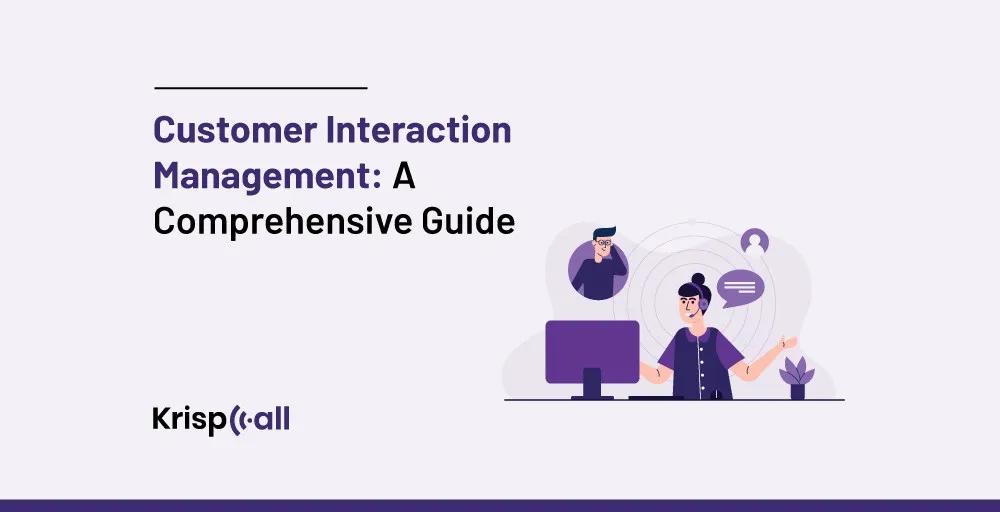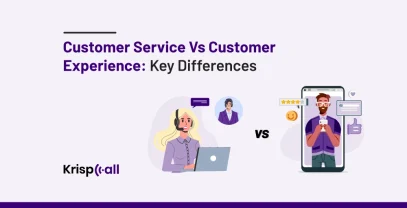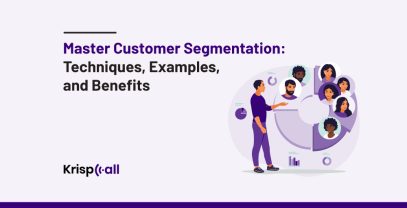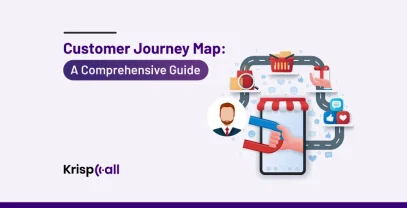Imagine entering a store where the staff knows your name, remembers your preferences, and always ensures you leave with a smile😊.
This level of personalized service is desirable and increasingly essential in a competitive market📈, the world of Customer Interaction management (CIM), a strategic approach to managing and optimizing every interaction 🗣️ a customer has with your brand.
In this guide, we’ll define CIM, explain why it’s critical in 2024, and discuss how you can implement effective strategies to boost your customer engagement. Additionally, we will explore how CIM can boost customer loyalty and satisfaction.
🔑KEY HIGHLIGHTS
- Customer interaction management systematically recognizes, attracts, accesses, analyzes, and interacts with customers in multiple connection points and contexts.
- Considering the current challenges that companies face daily, businesses that direct their efforts toward customer satisfaction will likely succeed.
- CIM stands for Customer Interaction Management, software that provides numerous tools for managing customer relations in real-time and across multiple touchpoints.
- The idea of CIM entails complete responsibility for the interaction between the business and the customer.
What is customer interaction?
Customer interaction is the direct communication between a customer and a company or organization employee. Sometimes, this can be face-to-face interaction, but it can also be done through calls, emails, social media accounts, live chat, etc.
Business personnel often do it to maintain customer satisfaction levels, solve customer disputes, and nurture meaningful customer relationships.

Managing interactions is critical in the business environment. Positive interactions with customers can improve the quality of services delivered and, in the long run, increase loyal customers’ sales of products and services. Conversely, negative interactions may have adverse effects that deter customers from accessing the firm’s goods and services.
CIM is an acronym for Customer Interaction Management, a strategic management strategy adopted by companies to manage all customer relations for a specific company in every channel.
Thus, by deploying a CIM strategy, companies ensure that customer service experience does not suffer at the hands of another employee.
What is customer interaction management?
Customer Interaction Management (CIM) is a systematic approach companies use to optimize customer interactions across various channels and touchpoints. It involves managing customer communications through different means, such as phone calls, emails, social media, and face-to-face interactions.
Understanding consumers’ behavior and requirements is crucial for CIM’s increased effectiveness. By interacting directly with the customer and gathering the necessary data, companies can better understand their customers and adjust their actions accordingly. This adds a significant advantage to CIM in achieving personalization goals, as businesses can schedule interactions that customers are willing to receive and engage with.

CIM also includes how an organization engages with customers based on different modes of communication, such as telephone, email, instant messaging or social networks, face-to-face interaction, and more.
When a business cultivates a system or digital customer experience strategy that delivers a positive customer experience through the many points of contact, it may have with the client or consumer.
What are the main channels for customer interactions?
A wide range of options is available for customers to contact businesses on the market. However, there are some that are used widely. Here are 7 of the most prominent channels that companies mostly use for customer interactions:
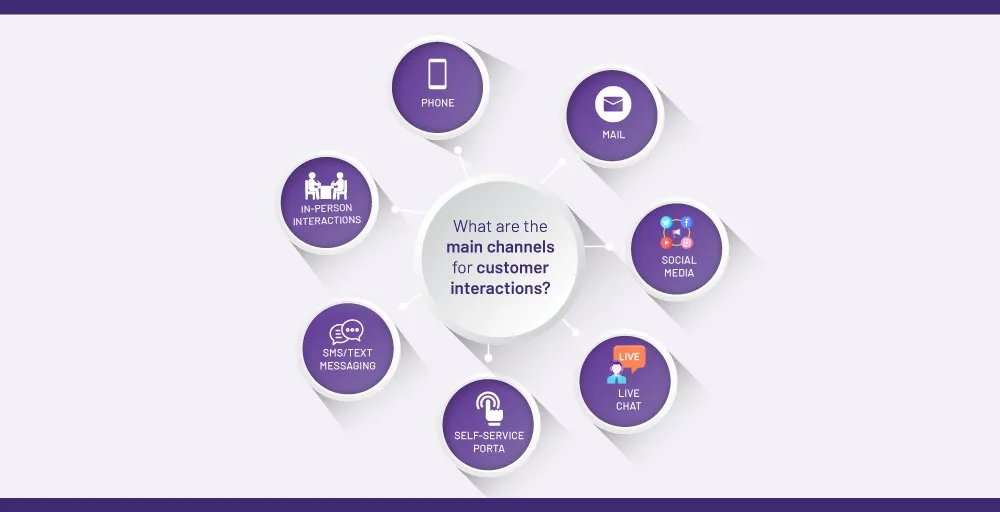
- Phone: Businesses use phone support to proactively reach customers, conduct surveys, and make personalized offers. They leverage features like call transfer, lVR systems, and voicemail to ensure timely and efficient communication.
- Email: Companies use email to send customers targeted campaigns, newsletters, and promotional offers. They also use email to nurture leads, share educational content, and provide personalized support.
- Social media: Businesses utilize social media platforms to engage with customers, respond to public concerns, and build their brand reputation. They also use AI transcription tools to monitor customer conversations and sentiment.
- Live chat: Companies deploy best live chat practices to proactively initiate conversations with website visitors, offer real-time support, and provide personalized assistance. They also use live chat to upsell and cross-sell products.
- Self-service portal: Businesses create self-service portals to empower customers to find answers and solutions independently. They use these portals to share knowledge bases, FAQs, and troubleshooting guides.
- SMS/Text messaging: Companies use SMS/text messaging to send targeted promotions, reminders, and customer updates. They also use SMS to provide quick support and resolve complex issues. They also use in-person interactions to gather feedback and conduct market research.
Businesses use various means in each channel to contact customers, including targeted marketing campaigns, personalized offers, and proactive support initiatives.
What are the benefits of customer interaction management for businesses?
Considering the challenges that companies face daily, businesses that direct their efforts toward customer satisfaction will likely succeed. With the help of Customer Interaction Management (CIM), companies can control customers’ interactions through different channels, thus leading to several benefits.
So, let’s look at five key benefits of customer interaction management for businesses:
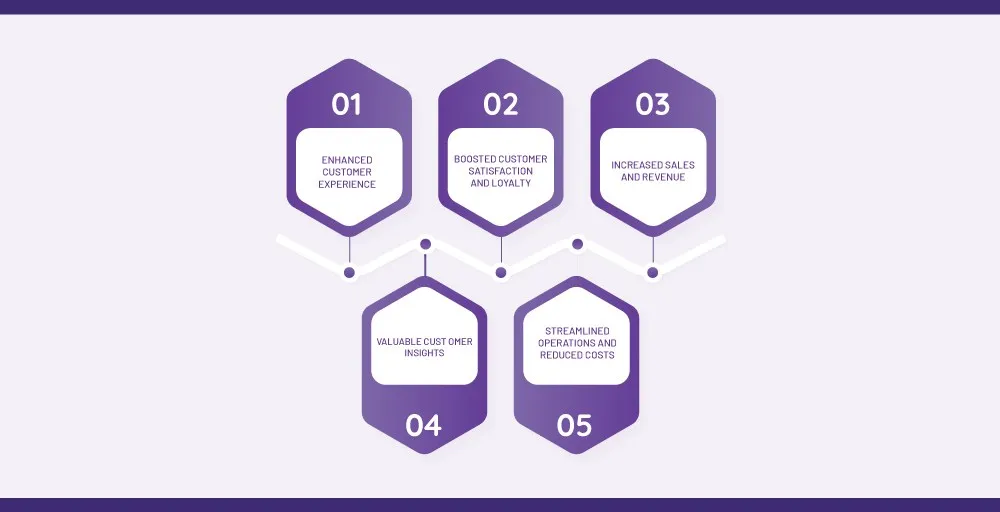
1. Enhanced customer experience
CIM also helps maintain the relevancy and continuity of messages at each point of contact. With it, businesses can visualize a customer conversing with a company representative and swinging directly to an email without repeating every detail twice.
This eradicates stress and enhances the flow and interaction of the customers, resulting in a more intelligent customer experience.
2. Boosted customer satisfaction and loyalty
To attract a constant flow of customers, one must satisfy their needs. CIM allows businesses to bond with customers, improving loyalty and positive relationships.
In other words, loyal customers will always be willing to do business with you again because they are satisfied with the products your company sells.
3. Increased sales and revenue
Ordinary and constant customers have become extremely valuable today. CIM helps maintain customer loyalty within the business and attracts new clients through positive word-of-mouth publicity. Also, through CIM, open issues can be effectively addressed before they lead to customer attrition, reducing sales.
4. Valuable customer insights
Customers represent an invaluable source of information containing concealed objectives. A CIM system can help businesses obtain a broader range of data through different networks. The findings of such assessments can be applied to understand customers’ choices and displeasures or to synchronize products and services to client’s preferences.
5. Streamlined operations and reduced costs
CIM goes beyond simple communication between machines or systems. It can help perform routine work more efficiently, including following up on an email chain or sorting incoming emails regarding clients. This proves helpful as your staff spends more time solving ‘bigger matters’ than generating client invoices.
What features should you look for in customer interaction management software?
CIM software provides numerous tools for managing customer relations in real time and across multiple touchpoints. When selecting a CIM solution, consider the following key features:
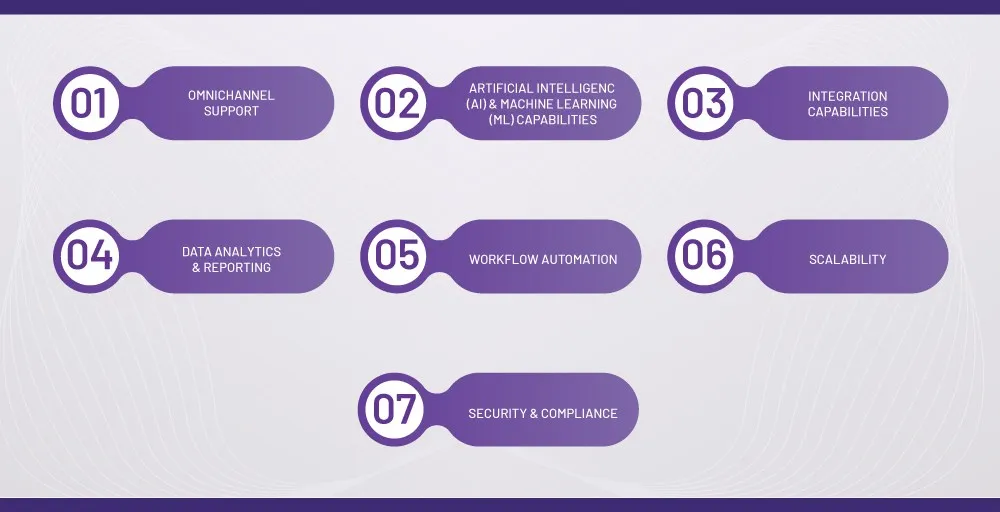
- Omnichannel support: When deploying a CIM solution, multiple interface points should be supported to encompass all interaction channels, including email, phone, chat, social media, and physical contact. This helps firms offer a uniform experience throughout the consumers’ lifecycle.
- Artificial intelligence (AI) and Machine learning (ML) capabilities: AI and ML can help automate repetitive work, analyze results, and give almost human-like results. Customer interaction management software with these customer experience technologies can aid businesses in getting crucial information about customer tendencies and inclinations.
- Integration capabilities: The CIM solution should be interoperable with other systems within the business environment, such as CRM, marketing automation, sales automation, and ERP systems. This helps create a more comprehensive customer view and improve business processes.
- Data analytics and reporting: Thus, the CIM solution should offer rich built-in data analysis and report generation features. Businesses can extract the various patterns of customer interactions and make informed decisions based on these patterns.
- Workflow automation: An efficient CIM solution should allow businesses to manage and support their aroused operational processes and workflows transitionally. This can assist companies in managing their operations more efficiently and effectively, minimizing expenses, and ultimately serving consumers better.
- Scalability: An evaluated CIM solution requires scalability capabilities to accommodate business expansion. It allows businesses to work with more customers and expand into new areas.
- Security and compliance: SGC, PSP, and MPP are the compliance components of CIM, while security can be seen as the main component of the CIM solution. This helps defend customer information and guarantee compliance with industry laws and regulations.
Types of customer interactions and ways to handle them
Here are the types of customer interactions and ways to handle them :
- New customers: These are new to your brand and require assistance with onboarding, understanding your products or services, and addressing any simple issues they may have. To maintain a positive image among new customers, it is important to provide social proof and good customer service in addition to transactional rewards.
- Potential customers: They are not your customers, meaning they haven’t bought your products but are willing to engage with your organization. Your website should have appealing and quality content to manage their attention and effectively communicate with them, ensure their overall satisfaction, prove your worth, and always have answers to their questions.
- Angry customers: These customers are unhappy with your services and may leave a negative review if their issues are not addressed. To deal with such consumers, it is necessary to supervise the customer service outlets, assume the best when dealing with such individuals, listen to and learn their grievances, and then provide possible solutions.
- Curious customers: These customers have visited your site, not once or twice but several times, meaning they are considerate buyers on the verge of ordering. This way, you will ensure that they are not only happy but can also administrate your website without many problems if your website offers some kind of informational content and has live chat support.
- Loyal customers: These customers love your brand and make repeat purchases. To keep them happy, show them appreciation, have their backs, offer them superior support, and thoughtfully provide services.
To handle these different types of customer interactions effectively, consider the following strategies:
- Personalization: Every consumer wants to feel special; therefore, adapt your communication style according to the buyer’s behavior, prior and subsequent choice, and purchasing habits concerning your product. This can assist in the establishment of customer trust concerning the brand as well as repeated purchases.
- Active listening: Listen to your customers’ concerns and feedback and respond promptly and empathetically. This can form a good impression and strengthen a company’s and clients’ mutual relationship.
- Problem-solving: They are more inclined to work with problem-solving clients where the solution provided directly responds to the customer’s need. This can help build trust and loyalty among consumers.
What are the strategies for improving customer interaction management?
The idea of Customer Interaction Management(CIM) entails complete responsibility for the interaction between the business and the customer. Properly approaching and managing the different stages of customer interactions may improve customer satisfaction, loyalty, and revenues.
Here are five strategies for improving customer interaction management:
1. Recognizing customer requirements and preferences
Understanding users’ requirements and preferences is the key to improving customer interactions. This can be obtained by collecting and analyzing customer data through various mediums. It helps businesses provide customers with customized experiences, fostering trust and loyalty.
2. Offering training and empowering staff
By providing extensive training and autonomy to staff, businesses can ensure that employees can handle customer interactions efficiently. Training ensures professionalism and leads to higher satisfaction and loyalty.
3. Provide a personalized experience
Personalization is adapting the average customer’s experience and other approaches to engaging customers, considering their behaviors and history with a company. It can serve the customers in a much more friendly, unique, and appealing manner, which can go a long way in attracting more customers and ensuring that existing customers keep coming back.
4. Efficient customer relationship management
CRM software is commonly used by organizations. CRM stores customer information to analyze their likes and dislikes. This data can then be used to make contextual advertised recommendations in various communication platforms like email, SMS, and social media.
5. Creating multichannel engagement
Business customers engage with businesses through various platforms, including e-mail, telephone, social media, and chat. Multichannel management refers to the coordinated and synergistic approach to dealing with all these points of customer contact.
How to choose the right CIM software?
To choose the right CIM (Customer Interaction Management) software, consider the following steps:

- Identify your needs: Determine your business needs, the frequency of customer interactions, the channel(s) used, and the necessary features.
- Research and compare options: Compare different CIM software and look for the one that fits your needs or has the required functions, as well as costs and feedback.
- Evaluate ease of use: The software’s development and whether your employees can quickly learn and adopt it should be considered. When selecting the software, consider features that include an easy and intuitive interface, training information, and customer support.
- Check for integration capabilities: Make sure that CIM approves itself for integration with other software in the company’s systems, including CRM, marketing automation, and analytics software.
- Test the software: First, do not purchase directly; use the free trial or demo version to test the software. By trying out the software, you will gain valuable insights about specific aspects such as functionality, stability, and functionality and confirm whether the software meets your requirements.
KrispCall — an example of customer interaction management software
KrispCall is far more than just a software solution; it is a complete solution for customer interaction. Whether you are a small business or a large enterprise, KrispCall enables you to grow and provide exemplary service.
For example, KrispCall effortlessly synchronizes with the most commonly used CRM systems, such as HubSpot and Keap. So as a result, your sales and marketing departments can easily access the information required to increase sales and provide exceptional customer support.
Moreover, with KrispCall, you can enhance your team’s collaboration more effectively during customer interactions. It lets your agents share call recordings, notes, and customer data with your integrated CRM to ensure synchronization.
Furthermore, learn how integrating KrispCall with your CRM can benefit your team, enhance your workflow, and provide customers with the individual attention they deserve. Contact today and schedule a free demo to see how your customer interaction management can be maximized.
Wrapping up
In conclusion, Customer Interaction Management (CIM) is a crucial strategy for businesses seeking to deliver exceptional customer experiences, drive loyalty, and stay ahead of the competition. By understanding customer needs, preferences, and behaviors, businesses can create personalized, omnichannel experiences that meet customers where they are.
Businesses can build strong, lasting customer relationships by leveraging data analytics, proactive issue resolution, real-time engagement, and continuous improvement. With the right tools, such as KrispCall, businesses can streamline customer interaction management processes, reduce costs, and increase revenue.
FAQs
What are the best five customer interaction management software?
The best five customer interaction management software are KrispCall, Freshdesk, Salesforce service cloud, Pipedrive, and Aircall.
Can small businesses also benefit from CIM, or is it primarily for large companies?
Yes, both small and large companies can benefit from CIM as it offers flexibility and scalability. This allows them to adapt to changing market conditions and improve efficiency without requiring significant upfront investments.
What are the differences between CIM and customer relationship management (CRM)?
The difference between CIM and CRM is that CIM mainly focuses on the customer journey across all devices to create an enhanced experience. In contrast, CRM primarily focuses on managing and optimizing direct customer interactions by using detailed data to personalize engagement and increase sales.
How can you collaborate effectively with both new and existing customers?
You can collaborate effectively with new and existing customers, making clear and transparent communication channels so that both parties understand each other’s goals and needs.
Can CIM software integrate with other business systems like CRM and ERP?
Yes, CIM software can integrate with other business systems, such as CRM and ERP, by enabling data exchange and coordination across various business functions.

